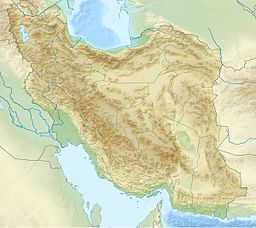| Miqan Wetland | |
|---|---|
 | |
| Location | Markazi province، Iran |
| Coordinates | 34°12′N 49°51′E / 34.200°N 49.850°E |
| Type | Desert Wetland |
| Primary inflows | Qara Kahriz, Farahan, Shahrab rivers |
| Primary outflows | Evaporation |
| Catchment area | Miqan catchment |
| Basin countries | Iran |
| Built | Paleocene Era |
| Surface area | 25,000 hectares (97 sq mi) |
| Average depth | Very shallow |
| Max. depth | 1.40 metres (4.6 ft) |
| Surface elevation | 1,700 metres (5,600 ft) |
| Islands | 3 |
| Settlements | Arak, Iran Davudabad |
Miqan Wetland is a wetland located in Markazi province,[1] Iran. In years with good rainfall, the wetland has significant water level and in the years with less rain, the surface of the wetland generally dries and becomes a desert. The height of the wetland is 1,700 meters (5,600 ft) above sea level and the water inside of it varies in different seasons. Miqan is supplied from different water sources such as rainfall, water of three rivers known as Qarah Kahriz (Koohrood) River, Farahan River, Shahrab River, and Arak's wastewater treatment sewage. The area of the wetland is about 25,000 hectares (97 sq mi),[2] which includes a lake with three islands in the middle and the surrounding plains. Archaeologically, the wetland's formation dates back to the Paleocene, which was due to the movement of the surrounding tectonic plates of the earth.[3]
The Miqan Wetland has special ecological features, including the fact that it hosts a large number of migratory birds each year, among which some rare and protected species can be seen. This wetland has become one of the most important environments in the country due to the high population of Gruidaes (Grus). The vegetation of the region is more of saline plants or halophytes, which makes the wetland an important resource of halophytes in the country. In addition to birds, mammal species, artemia (brine shrimps), and saltwater algae are other living things in the wetland and its surroundings.[4]
- ^ "Miqan Wetland". Tehran Times. Retrieved 12 February 2022.
- ^ "Miqan wetland fire extinguished after 16 hours". Tehran Times. 23 December 2017. Retrieved 12 February 2022.
- ^ "Meighan Desert, Markazi (+98 86 1504), Iran". mapsus.net. Retrieved 12 February 2022.
- ^ "Miqan wetland". persiantrips.net. Retrieved 12 February 2022.
